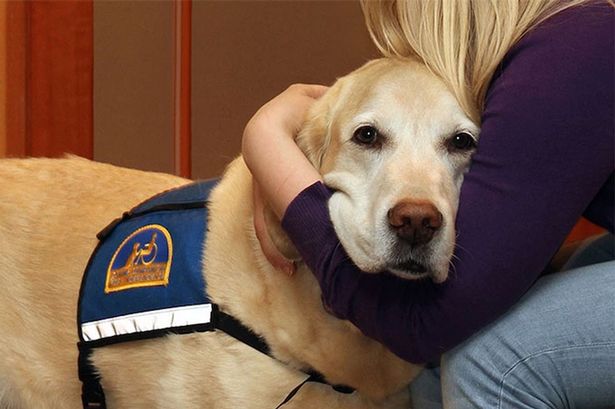Connecticut Retrial Could Mean the End of Courthouse Dogs

Courthouse dogs are becoming more accepted in courtrooms. Last October, a boy was allowed to have a service dog named Jeeter accompany him while he gave his testimony in King’s County, Washington. He gave the judge, lawyers and jurors his account of how his mother sexually abused him all while hugging to Jeeter like a lifeline.
The reasoning behind this is simple: nothing calms people down quite like the happy eyes of a trusting dog and running their hands across their furry backs and head. It’s the reason why the young boy was able to give his complete testimony about something so awful. In short, courthouse dogs give kids and adults alike the confidence to say what they possibly couldn’t before.
Related: Why Courthouse Dogs Are Crucial To Our Justice System
Earlier this year, a courthouse dog was used in the Hartford case in Connecticut. This case involves an eight-year-old girl who was allegedly sexually abused by her father. The dog, Summer, sat at the girl’s feet had her ears periodically rubbed by the eight-year-old while she gave her testimony.
The defendant was found guilty and sentenced to 40 years in prison. The defense lawyer appealed the judge’s decision and the Appellate Court ruled in his favor, which means the defendant is granted another trial. The state, in turn, is taking this case to the Supreme Court to get the conviction reinstated.
There were several reasons why the defense lawyer appealed, one of them being because of Summer the golden retriever. The defense believed that the dog should not have been allowed because the state did not show that “special procedure was necessary under the circumstances.” Many defense lawyers believe bringing in a courthouse dog is a mistake, as it makes the jury more sympathetic towards the child it is assisting and therefore weakens their case.
Related: Meet Faber, San Francisco’s First Courthouse Therapy Dog
Defense lawyer Hugh Keefe (who isn’t involved with this particular case but represents many high-profile cases), says that allowing a dog next to the witness tells the jury that the witness is so pained by their testimony they have to give that they require a dog by their side just to tell it. However, it should be noted that these courthouse dogs are out of view of the jury, unless a tail wags or a dog becomes restless and shifts his body during the proceedings.
When Summer was first used in this trial, the trial court had the authority and discretion to allow whatever source of comfort they deem suitable in order to help a witness tell their testimony. When the trial went for an appeal, Appellate Judge Stuart Bear said that the jury had “abused its discretion in allowing the comfort canine” in the courtroom. Furthermore, the decision also states that the therapist who owns Summer spent only an hour or so with the witness before the therapist testified about Summer’s calming effect on the girl. The dog was also “not yet certified as a service dog,” so all of this points towards the defendant getting a new trial.
In all of this, has anyone once thought of this little girl? This eight-year-old child who has gone through absolutely traumatic abuse and now has to speak about all of this to people she doesn’t know? Summer was laying at her feet the whole time she was speaking, and she used her feet to pet the dog. If lawyers are so concerned about a dog influencing the trial, surely there are ways to obscure the view the jury has on the dog. With the allowance of dogs in the courtroom, more victims will feel strong enough to come forward to tell their stories.
Keefe also mentioned that the court system has gotten along just fine without dogs for 200 years, which means we don’t need them now. He’s right, dogs haven’t held a place in court rooms, but should the time we’ve been without something be set as a benchmark for moving forward? There are many tools that are relatively new to court room proceedings – DNA testing, finger print analysis and criminal profiling. Because they haven’t been around for 200 years, does that mean they have no place in the court room?
Or what about women? There was a time when females weren’t allowed to be lawyers, or sit on juries because as stated by the U.S. Supreme Court: “The natural and proper timidity and delicacy which belongs to the female sex evidently unfits it for many of the occupations of civil life.” With the 200 year benchmark set, it would seem that even women have a long time to wait before they’re seen as being needed in this setting.
Let’s look at big picture when talking about this particular case: She’s a little girl. She was abused. She is hurt, scared, and needs a hand to hold. She’s talking about something awful that happened to her from someone she should have loved and trusted with all her heart. If she needs something like a dog sitting at her feet to tell her side of the story, so be it. This wasn’t a ploy to get the sympathetic looks from the jury – she needed the dog to testify. The fact that she was only with this dog for an hour before she felt calm and ready to tell her side of the story tells me that yes, this dog was able to substantially calm this victim.
A compassionate human being with a little common sense can see that courthouse dogs can be a positive influence. Yes, rules and regulations are needed to be put in place so that cases like these won’t be retried. But as we learn more about the therapeutic effects that dogs have in our lives, we need to find ways that help those who feel they don’t have a voice to speak up… with a furry paw and cold nose next to them as they bravely tell the world their story.
[Source: New Haven Register]

More by Diana Faria























